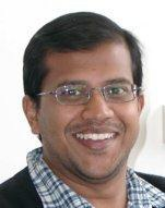Structural investigations on semiconductor nanostructures
Wet chemical approaches for the synthesis of novel functional structures
Promotion date: October 24.
Promotor: Prof. dr. Miko Elwenspoek and
Prof. dr. Margit Zacharias
| This thesis is mostly focused on the fundamental study about the fabrication of functional semiconductor nanostructures by wet chemical approaches: in particular, the effects of structure-directing agents. Zinc-oxide is intrinsically an n-type semiconducting materials that finds applications in electronics, optics, and catalysis. ZnO nanowires have been emerged as a potential candidate in various modern devices with enhanced efficiency. Hydrothermal growth is a widely used technique for the synthesis of ZnO nanowires owing to cost effectiveness, simplicity, and up scaling. The use of a polymer additive, polyethylene glycol, in the reaction medium has a huge effect on the final morphology of the prepared structures. This method is used to grow hexabranched ZnO nanostructures with increased total and polar surface areas. The structures showed enhanced photocatalytic activity as compared to conventional nanowires. Controlled secondary growth approaches using organic capping agents, in combination with doping, have also been intrigued for the preparation of ZnO core-shell nanowires. Sb-doped and Co-doped ZnO core-shell nanowires have been prepared this way. The Sb-doped ZnO core-shell nanowires have been synthesized using polyethylene glycol-assisted process in an aqueous medium. The Co-doped ZnO core-shell nanowires have been prepared in an ethylene glycol-assisted process where ethylene glycol acts both as the growth medium and a structure-directing agent. Since both routes use a secondary growth method, the shell is grown on an already prepared nanowire core, good site-selectivity is achieved. CuI is intrinsically a p-type semiconductor that is applied in solar energy conversion, catalysis, and solid electrolytes. Antisolvent crystallization of CuI nanoparticles and their assembly to form superstructures are also discussed. This process has been tuned using polymer additives to obtain specific morphologies with high porosity. The superstructures have been used as sacrificial templates to fabricate highly convoluted and porous CuO and TiO2 structures. The CuI superstructures prepared by polymer assisted assembly have been used as adsorbents. They showed a high adsorption capability. |
Was your work fundamental in nature?
Yes it was. The main part of my thesis work was fundamental in nature. Using polymers as structuring agents is a quite novel approach in this field of research. Using salt solutions is more common. Novel functional structures resulted from my work.
Using structuring agents can affect the morphology, thus improving the efficiency for example in solar cells. Here, industry partners are interested in especially, as we succeeded in fabricating structures based on glass-plate templates.
The group I was working in will take on this research theme in the years to come, aiming towards application issues, like further improving the electronic properties of the functional structures involved.
Can you recall some special moments during your PhD working period?
In one of the experiments - in which I expected a fairly ‘thick’ ZnO nanowire - suddenly a new structure with a star-like morphology formed. Me and my colleagues were completely surprised by this. We collaborated on finding a good explanation for this phenomenon. We succeeded in that, which led to a good publication.
In what journals were your results published?
Articles appeared in the Journal of Micromechanics and Micro-engineering. ACS Nano published two articles. One article is submitted at this very moment.
Who were your collaboration partners and institutes on this work?
The main part of the work was done at the Univeristy of Freiburg, at IMTEK- Nanotechnology group. The silicon structures were prepared in Twente, using new fabrication technologies and equipments. This was done at the Transducers Science and Technology Group.
What are your future plans?
I like to continue my career in academics as it gives me great freedom in pursuing my own ideas. There is room to try out project plans and sideways in an independent way. This I appreciated already very much during my PhD work. Now I am applying for a position in Europe.
The open spirit of research at Mesa+, I learnt to appreciate. There is always room and time to talk and discuss about ideas one brings in. My colleagues were able to turn bad ideas into really good ones.
What, in your opinion, is important for Mesa+ to stay successful in future?
I have spent only little time at the Mesa+ Nanolab. The role of the technicians is especially important in my opinion. Their expertise is very good and they are always willing to help you out. Working in the cleanroom in collaboration with them was a nice experience.

